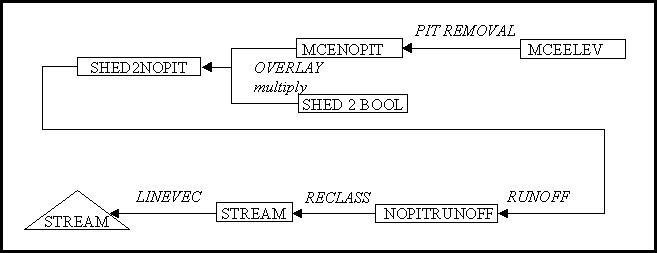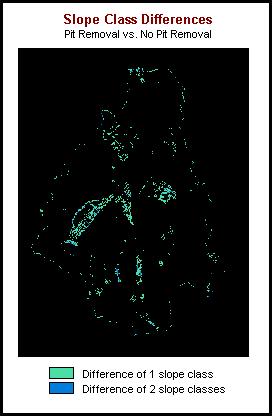
The development of a stream layer was not important at all, other than for visualization. This is the reason that I decided, after having finished all the analyses, to create such a layer (as seen on the Spatial Analyses page). To do this, I ran the PIT REMOVAL module on the DEM, "clipped" the watershed 2 region using the OVERLAY module, ran the RUNOFF module (which calculates the amount of runoff for every cell), and then used RECLASS to mask out all the cells with low runoff, leaving only the high runoff stream channels left, which I then converted to vector format. This worked perfectly.

The problem was that the process made me realize that I had not run PIT REMOVAL at the very begining of the project before calculating and using slope data derived from the DEM. However, I was not about to redo the entire project. Instead, I decided to examine the shortfall as a source of error. After running PIT REMOVAL on the original DEM, I derived a map of slopes and categorized it into the same 4 classes as before. After "clipping out" water shed 2, I performed a subtraction overlay to reveal any points where there had been a difference. The resulting layer displayed how much of a discrepancy between the "no pit" layer and the one I had used existed, in terms slope classes. I used RECLASS to produce a map that showed areas where the difference was only one slope category and where it was two. Using AREA and a couple calculations, I determined the proportion of the study watershed affected by this error.
| Difference of 1 Slope Class | 3.5% of Watershed Area |
| Difference of 2 Slope Classes | 0.5% of Watershed Area |

The runoff coefficient will be wrong in these small areas: however, the impact of that difference will be negligible because they represent such a small area. Of course, this assumes that the DEM values for every cell are accurate to begin with. The DEM values do not represent sampled measurements from the actual site but interpolated values based on a a particular sampling and interpolation model.